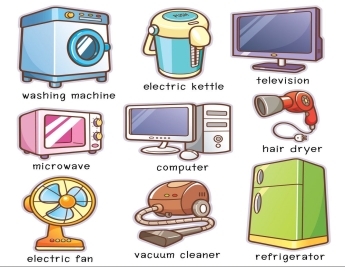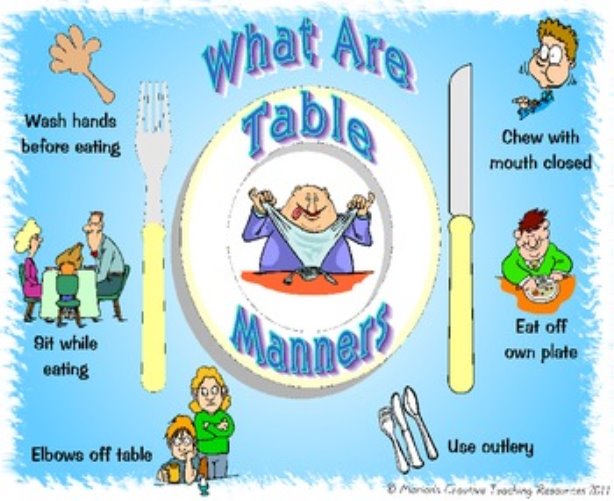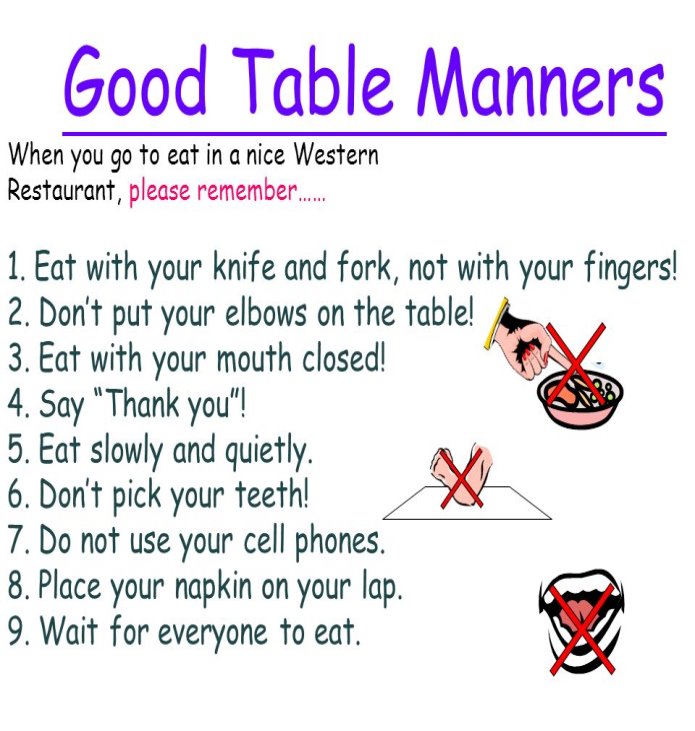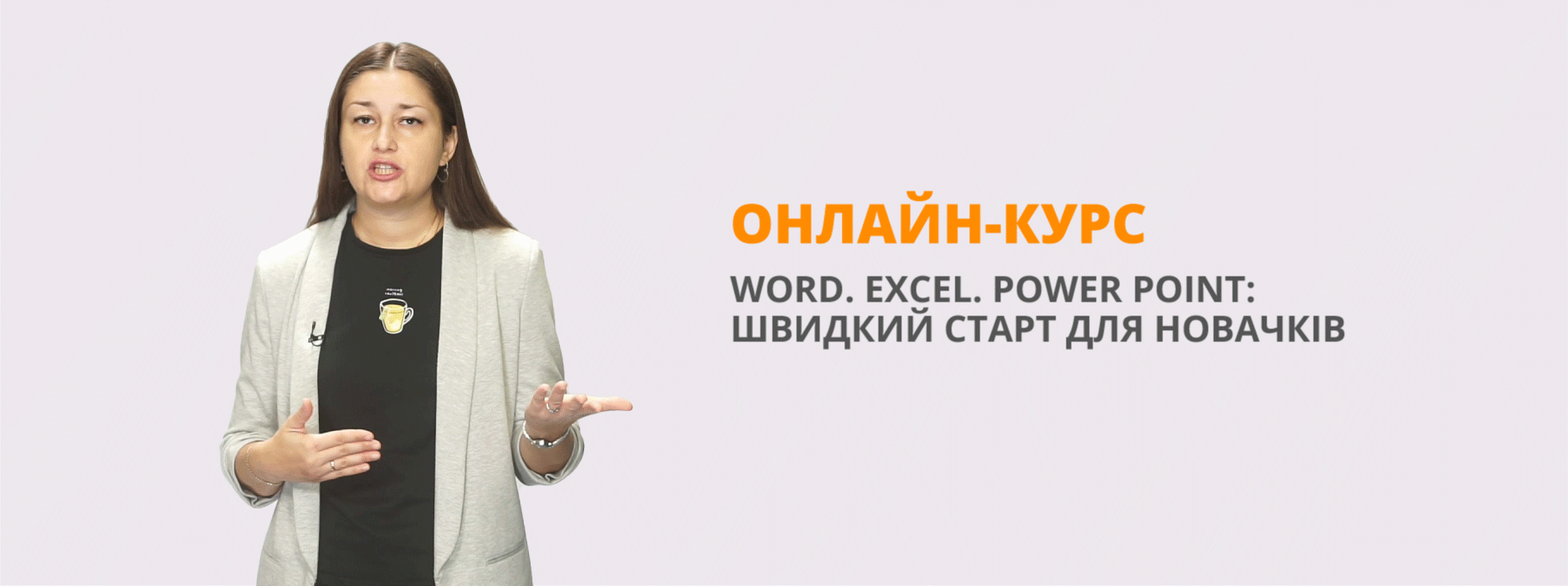Урок за темою "Правила поведінки за столом"
Тема: Правила поведінки за столом
Цілі уроку: активізувати та удосконалювати усі види компетентностей в учнів: читання, письмо, аудіювання та говоріння, закріпити лексику теми; ознайомити з правилами поведінки за столом, зі специфікою їх вживання; удосконалити усно-мовленнєві вміння учнів; розширити кругозір учнів у межах теми; розвивати вміння учнів здійснювати мовленнєву діяльність, розвивати самостійність у праці, збагатити зміст основної навчальної мети; розвивати мовну здогадку; залучити учнів до комунікативних форм діяльності на уроці: робота в парах, групах, розвивати мислення та вміння спілкуватися один з одним; виховувати позитивне ставлення до іноземної мови, до обраної професії, вчити учнів бути уважними, організованими та активними.
Компетентності: спілкування іноземними мовами, математична компетентність, основні компетентності у природничих науках і технологіях, уміння вчитися впродовж життя, ініціативність і підприємливість, соціальна та громадянська компетентності
Тип уроку: розвиток компетентностей
Обладнання уроку: ілюстративний матеріал, картки для читання, говоріння, письма, телевізор, відео (https://www.youtube.com/watch?v=_UTIlxTfc_0), worksheet https://www.liveworksheets.com/cz903737ld
Хід уроку
І. Початок уроку
- Greeting Good morning. How are you?
- Warm – up
Let’s begin with the tongue – twister :
Rub – A – Dub – Dub
Three men in a tub:
The butcher, the baker,
The candlestick maker.
Listening We have known some new professions from this tongue – twister. You have already known a lot of professions. Look, I have some letters from different people. I want to read these letters, and you’ll say what these people are.
- I like children very much. I like to read books and to write on the blackboard too.
What am I?
- I like children very much, but I do not like to write on the blackboard. I go to the hospital every day. What am I?
- I like cars and buses. I like to travel very much. I can drive a car, a bus and a tram too.
What am I?
- I like flowers and trees. Every day I go to the garden and water flowers there. What am I?
You are very good pupils. And now tell me, please, what professions do you know else?
Let’s make up “A Map of Professions of our technical school”.
II. Основна частина уроку
- Оголошення теми та мети уроку.
Today we are going to know what profession is the best. First of all, I want to show you our plan of the lesson. Look at the blackboard, please.
Plan
- Where do your parents go every day?
- What do they do there?
- What is the most important profession in our life?
- What is the best profession?
- What do you want to be?
- Актуалізація опорних компетентностей
worksheet https://www.liveworksheets.com/cz903737ld
Speaking
Name the cooking equipment. What do we need them for?

- Ознайомлення з новим матеріалом
Pre-reading activity
Speak about the table manners you should observe in your homes or in the public cafeteria. What do you do before eating? Are there rules about your hands or the way you sit? What do you do at the end of a meal? Why do we have rules about how to eat? Have you ever been in situations where the rules you are used to are not appropriate?
Reading
Different Countries, Different Etiquette
Whether one is travelling for business or for pleasure, new cultures are generally part of the process. Although there are many differences between cultures in the world, there are also similarities. The similarities do not get us into trouble, but the differences can destroy a business deal or a pleasure trip. Learning some facts and some of the patterns of other cultures, as well as various travel customs and tips, can help you be successful.
France
In a country where food is king it's good to have courtly manner. So:
• Don't cut your salad with a knife or fork. Instead fold your salad on your fork using your knife.
• Never cut bread. Break bread with your fingers. And usually there aren't bread/butter plates. So place your bread on the table above your dinner plate on the left.
• Cut cheese vertically. Do not cut off the points.
• Never eat fruit whole – Always peel and slice it before eating.
• When you're finished eating, place knife and fork side by side on the plate at the 5:20 position. The fork should be on the left and the knife should be on the right with the blade of the knife facing the fork.
• To signify that you would like more food, cross your knife and fork across your plate.
Italy
Italians are known for expressing themselves through body language. So:
• Greet friends with a kiss on both cheeks.
• Keep eye contact while talking. If not, Italians think you are hiding something.
• To call a waiter or waitress, raise your index finger and make eye contact.
• Stand when an older person enters the room.
China
In China, it's all about respect. So:
• When introduced to a group of Chinese people, they may greet you with applause. Be sure to applaud back.
• Greet the oldest, most senior person first.
• Address the Chinese by Mr., Mrs., Miss plus family name.
• The Chinese dislike being touched by strangers. Other than shaking hands when greeting them, do not hug, lock arms or make any other body contact.
Argentina
Always fashion-conscious. So:
• Dress well if you want to make a good impression.
• Women are expected to dress stylishly.
• And don't be offended by their humor, which may mildly attack your clothing or weight.
- Закріплення набутих компетентностей
Post-reading activity
Questions after reading:
1. What are the differences and similarities between the table etiquette in your country and the countries that you have read about?
2. What are some mealtime habits or rules in your home that a visitor from one of these countries may find unusual? What could you do to make your visitor feel comfortable?
3. How did you learn what behavior is appropriate at mealtime?
4. Why are rules of etiquette so important? Whose rules do you follow when you're sharing a meal at someone's house? Whose rules do you follow in a restaurant?
Watching a video https://www.youtube.com/watch?v=_UTIlxTfc_0
Listening
Table manners in Ukraine:
- DO partake in toasts. Toasting is a very important part of Ukraine's social culture.
- DO be prepared with an excuse if you don't drink. If you don't drink alcohol, blame it on an medical problem. Ukrainians can sometimes be suspicious of people who don't drink.
- DON'T clink glasses during a toast if you aren't drinking alcohol.
- DON'T eat until the host invites you to begin.
- DO rest your wrists at the edge of the table.
- DON'T refuse a dish. Try everything and save room for seconds. Turning down food could be seen as rude.
- DON'T leave an empty bottle on a table. It's considered bad luck.
- Put your napkin on your lap when the food is served. After you have finished eating wipe your hands and mouth with the napkin and then put it on the table on the left of your plate. Don’t fold it, don’t wipe your face with it.
Writing
Fill in: DO and DON’T
- … partake in toasts. Toasting is a very important part of Ukraine's social culture.
- … be prepared with an excuse if you don't drink. If you don't drink alcohol, blame it on an medical problem. Ukrainians can sometimes be suspicious of people who don't drink.
- … clink glasses during a toast if you aren't drinking alcohol.
- … eat until the host invites you to begin.
- … rest your wrists at the edge of the table.
- … refuse a dish. Try everything and save room for seconds. Turning down food could be seen as rude.
- … leave an empty bottle on a table. It's considered bad luck.
- … Put your napkin on your lap when the food is served. After you have finished eating wipe your hands and mouth with the napkin and then put it on the table on the left of your plate. Don’t fold it, don’t wipe your face with it.
III. Заключна частина уроку
- Home task
- Conclusion
We have worked very hard today. We spoke, wrote, read and answered questions. I must say you are good pupils. Your marks are… Good-bye.
Different Countries, Different Etiquette
Whether one is travelling for business or for pleasure, new cultures are generally part of the process. Although there are many differences between cultures in the world, there are also similarities. The similarities do not get us into trouble, but the differences can destroy a business deal or a pleasure trip. Learning some facts and some of the patterns of other cultures, as well as various travel customs and tips, can help you be successful.
France
In a country where food is king it's good to have courtly manner. So:
• Don't cut your salad with a knife or fork. Instead fold your salad on your fork using your knife.
• Never cut bread. Break bread with your fingers. And usually there aren't bread/butter plates. So place your bread on the table above your dinner plate on the left.
• Cut cheese vertically. Do not cut off the points.
• Never eat fruit whole – Always peel and slice it before eating.
• When you're finished eating, place knife and fork side by side on the plate at the 5:20 position. The fork should be on the left and the knife should be on the right with the blade of the knife facing the fork.
• To signify that you would like more food, cross your knife and fork across your plate.
Italy
Italians are known for expressing themselves through body language. So:
• Greet friends with a kiss on both cheeks.
• Keep eye contact while talking. If not, Italians think you are hiding something.
• To call a waiter or waitress, raise your index finger and make eye contact.
• Stand when an older person enters the room.
China
In China, it's all about respect. So:
• When introduced to a group of Chinese people, they may greet you with applause. Be sure to applaud back.
• Greet the oldest, most senior person first.
• Address the Chinese by Mr., Mrs., Miss plus family name.
• The Chinese dislike being touched by strangers. Other than shaking hands when greeting them, do not hug, lock arms or make any other body contact.
Argentina
Always fashion-conscious. So:
• Dress well if you want to make a good impression.
• Women are expected to dress stylishly.
• And don't be offended by their humor, which may mildly attack your clothing or weight.
Questions after reading:
1. What are the differences and similarities between the table etiquette in your country and the countries that you have read about?
2. What are some mealtime habits or rules in your home that a visitor from one of these countries may find unusual? What could you do to make your visitor feel comfortable?
3. How did you learn what behavior is appropriate at mealtime?
4. Why are rules of etiquette so important? Whose rules do you follow when you're sharing a meal at someone's house? Whose rules do you follow in a restaurant?
Table manners in Ukraine:
- DO partake in toasts. Toasting is a very important part of Ukraine's social culture.
- DO be prepared with an excuse if you don't drink. If you don't drink alcohol, blame it on an medical problem. Ukrainians can sometimes be suspicious of people who don't drink.
- DON'T clink glasses during a toast if you aren't drinking alcohol.
- DON'T eat until the host invites you to begin.
- DO rest your wrists at the edge of the table.
- DON'T refuse a dish. Try everything and save room for seconds. Turning down food could be seen as rude.
- DON'T leave an empty bottle on a table. It's considered bad luck.
- Put your napkin on your lap when the food is served. After you have finished eating wipe your hands and mouth with the napkin and then put it on the table on the left of your plate. Don’t fold it, don’t wipe your face with it.
Writing
Fill in: DO and DON’T
- … partake in toasts. Toasting is a very important part of Ukraine's social culture.
- … be prepared with an excuse if you don't drink. If you don't drink alcohol, blame it on an medical problem. Ukrainians can sometimes be suspicious of people who don't drink.
- … clink glasses during a toast if you aren't drinking alcohol.
- … eat until the host invites you to begin.
- … rest your wrists at the edge of the table.
- … refuse a dish. Try everything and save room for seconds. Turning down food could be seen as rude.
- … leave an empty bottle on a table. It's considered bad luck.
- … Put your napkin on your lap when the food is served. After you have finished eating wipe your hands and mouth with the napkin and then put it on the table on the left of your plate. Don’t fold it, don’t wipe your face with it.




про публікацію авторської розробки
Додати розробку
